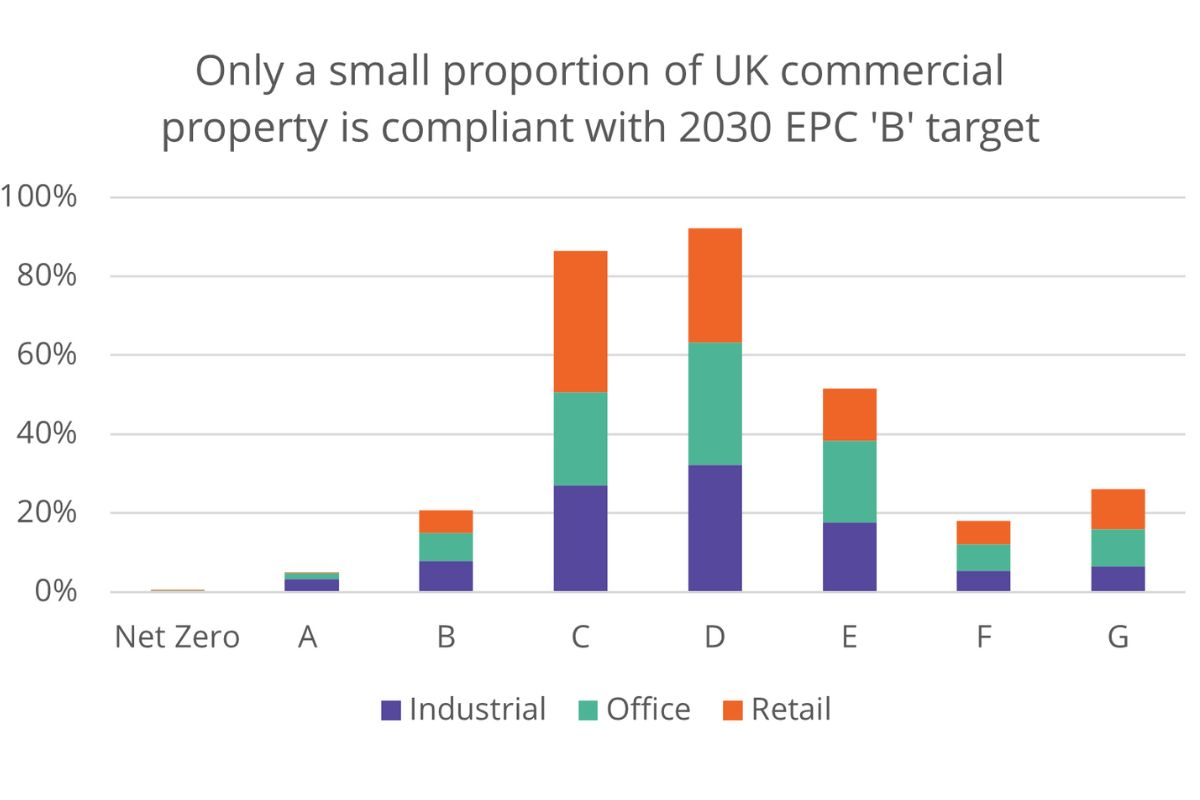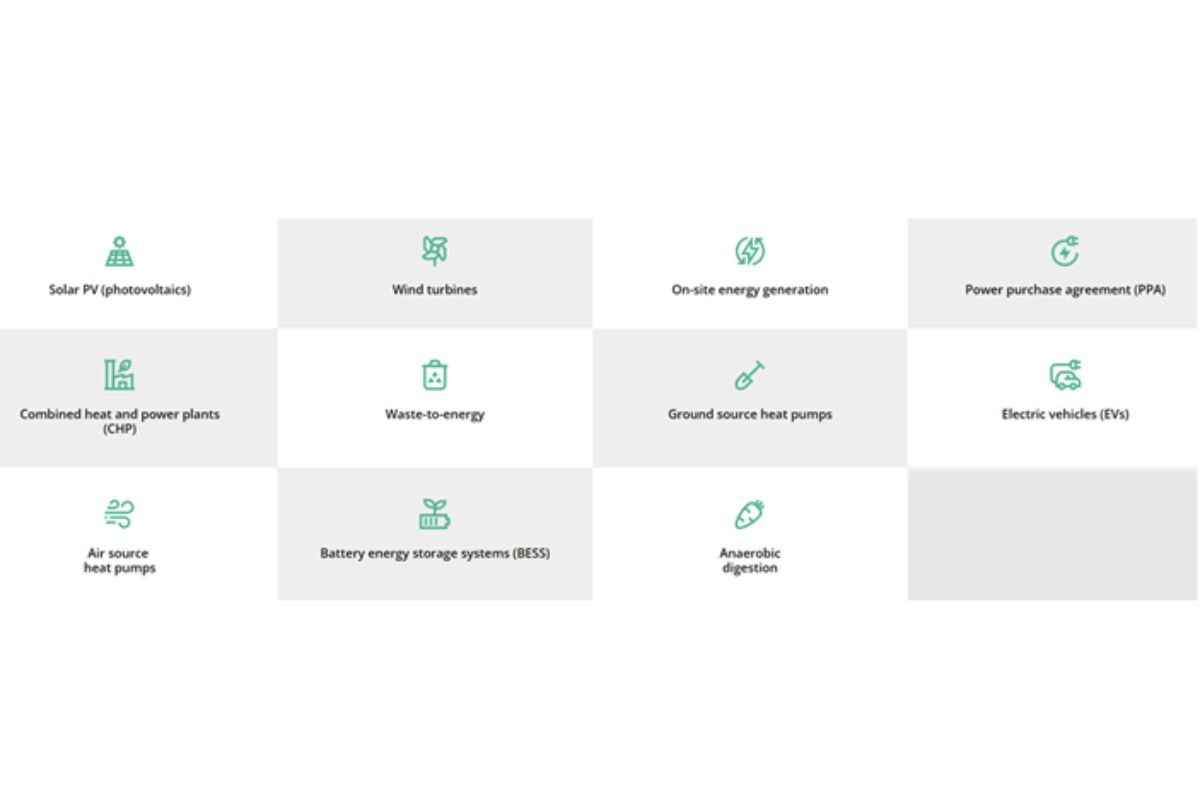How are the public and private sectors delivering decarbonisation strategies across the UK?
Achieving net zero emissions by 2050 is one of the most pressing challenges for the real estate sector. With over 84% of the UK’s population living in urban locations, the stakes are high.
Many urban centres are vibrant places, appealing to both residents and visitors alike, because of their cultural heritage, their diversity, their easy access to retail and leisure, strong transport connections as well as job opportunities. However, these areas face significant hurdles in their attempts to meet net zero emissions targets, whilst grappling with the crisis in funding shortfalls at the same time. With buildings accounting for around 40% of carbon emissions, both local and central government are having to partner with the private sector to help reach these goals.
In response to this challenge, the UK government implemented legislation for building owners (in England and Wales) mandating minimum Energy Performance Certificates (EPCs) standards. Initially, in 2018, the focus was on buildings either sold or newly let, which needed to hold a minimum EPC grade of E or above. In 2023, this was extended to all commercial properties including those under existing leases. By 2030, the minimum EPC grade required for a commercial building will increase to a B or above.
What are commercial property owners doing to lower carbon emissions from their buildings?
Despite this, research carried out by Avison Young shows that compliance levels of the 2030 target are alarmingly low: only 11% of industrial, 12% of retail and 9% of office properties have a minimum EPB B grade. This deadline is less than 6 years away, meaning landlords need to take action soon to avoid the risk of buildings becoming unlettable.
As part of the research, we assessed the cost of upgrading stock in the retail and industrial sectors, which proved to be substantial. To upgrade retail stock (retail parks, shopping centres and supermarkets) the estimated total cost for achieving the 2030 ‘B’ target came to a maximum of £24bn, and over £30bn for industrial stock.
Whilst these costs present huge challenges ahead for building owners as the deadline approaches, there are some inspiring examples of both new and retrofitted buildings which are achieving ‘A+’ grades across both sectors. Launched in 2018, the Elliots Field Shopping Park in Rugby became the world’s first ‘zero regulated carbon’ shopping park globally, featuring design elements that minimised energy demands such as PV panels, LED lighting, rainwater harvesting as well as the creation of a canal bankside nature area for wildlife. This building is listed on the EPC register as ‘net zero’.
Whilst there are no ‘net zero’ shopping centres listed on the EPC register currently, there are some good examples of energy efficient shopping centres.
This includes Quayside at MediaCity in Salford and Gloucester Quays in Gloucester, which were the first UK shopping centres to achieve a ‘Net Zero Carbon – Operational Energy’ status in relation to the UK Green Building Councils’ (UKGBC) Net Zero Carbon Buildings Framework. To achieve this status, upgraded lighting, which was more energy efficient, was introduced across all areas and the use of renewable energy was increased across both locations.
In Nuneaton, a one million sq. ft state-of-the-art logistics campus has completed. The two buildings, occupied by Rhenus Logistics, have been designed to achieve carbon net zero supply chains. It has been built to the highest environmental and sustainability levels, featuring the latest digital technology in robotics, AI and warehouse management systems to provide flexible solutions and control of the supply chain and is certified BREEAM Outstanding. In addition, the scheme’s design has focussed heavily on social and environmental well-being, including initiatives such as encouraging biodiversity by planting numerous trees, creating log piles and bee, bat and bird boxes. Employee allotments, outdoor seating areas, sports facilities, and walk and running tracks have been installed, providing staff with green, open spaces to enjoy.
How are cities tackling decarbonisation?
Whilst building owners are embarking on their own paths to achieve net zero, local authorities across the UK are stepping up with bold initiatives, launching their own carbon neutral commitments, and engaging with residents, local businesses and strategic partners to reduce carbon emissions in line with the national 2050 net zero target. But the latest data from the Office of National Statistics (ONS) reporting on greenhouse gas emissions shows that emissions only fell by 3.5% between 2021 and 2022 and were just 9.3% lower than pre-pandemic levels. This demonstrates that a significant amount of effort and resource will need to be invested across the UK in the coming years to address this challenge.
However, there are some good examples of initiatives from local authorities across the country who are leading the way in their attempts reduce carbon emissions.
One of the most innovative strategies is being implemented in Bristol, where the city council has set itself a target of becoming carbon neutral by 2030. ‘Bristol City Leap’ is a joint venture between the council, Ameresco (a renewable energy company) and Vattenfall (a European energy company), which will deliver hundreds of millions of pounds into low carbon energy infrastructure, including solar, wind, heat networks, heat pumps and energy efficiency measures to help meet its carbon reduction targets. This will enable the delivery of over £1 billion of investment into Bristol’s energy system and within 5 years plans to deliver 140,000 tonnes of carbon savings.
To enhance local biodiversity Sunderland City Council have installed living roofs (also known as ‘Bee Bus Stops’) across 90 bus shelters in the city. These living roofs, which are made of recycled materials, sit on top of the bus shelters and are planted with a mix of wildflowers to support bees whose numbers are declining. They also help provide natural cooling to combat the effects of ’urban heat islands’, absorb rainwater to alleviate flooding, and filter fine dust particles from the air.
In Edinburgh, planning permission has been approved for a new ‘eco neighbourhood’ in the city centre.
The development will consist of 256 sustainable homes (of which 25% will be affordable) and will include a large central communal garden, biodiverse green roofs, and a ‘wetland’ area. No fossil fuels will be used, as each home will also its own air source heat pump.
There are still major challenges ahead to tackle decarbonisation
While EPCs are a critical part of the route to decarbonisation, the broader challenge lies in managing the reduction of Scope 3 emissions (indirect emissions from supply chains). This requires collaboration across supply chains and industries. Organisations must work closely with suppliers to track and reduce indirect emissions, leveraging technology and innovation.
Recent policy shifts and rolling-back of some green initiatives, including delaying the ban on petrol and diesel cars, pose challenges to achieving the 2050 net zero target. It is crucial for policymakers to provide clear, unwavering support for decarbonisation initiatives, including financial incentives and regulatory frameworks. The positive news though is that many organisations in the property industry have the knowledge and the influence to take actionable steps towards decarbonisation and can work together with the public sector to achieve net zero targets.
The path to net zero is fraught with challenges, but also ripe with opportunities. By learning from successful case studies and fostering collaboration between the public and private sectors, the UK can make significant strides towards a sustainable future. Now is the time for decisive action, innovative solutions, and unwavering commitment to our climate goals.
Lesley Males is director, market intelligence at Avison Young
Our cities, placemaking, living and the net zero challenge programme is supported by E.ON, Equans and Mears





